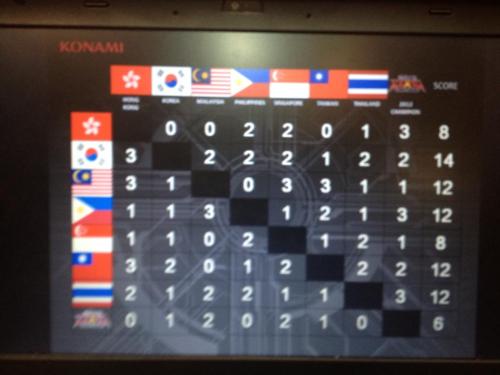 The Yu-Gi-Oh! Asia Championship 2013 has concluded recently, with South Korea winning their very first Asia Championship.
The Yu-Gi-Oh! Asia Championship 2013 has concluded recently, with South Korea winning their very first Asia Championship.
Though the event was a great success, Konami Asia has uphold their tradition of implementing terrible tournament format. Switching back from a Swiss with Playoffs format to a Round Robin format was a good idea, but the execution leaves much to be desired.
–
Format
Round Robin was the format of choice.
Players are awarded points according to the results of their duels as follow:
- 2 Wins 0 Loss (2W0L) – 3 points
- 2 Wins 1 Loss (2W1L) – 2 points
- 1 Win 2 Losses (1W2L) – 1 points
- 0 Win 2 Losses (0W2L) – 0 point
The winners are determined by their total accumulated points.
In the event that players has the same amount of points, the tiebreakers are determined by the amount of 2 Wins 0 Loss. That is to say, the player that won more matches with 2 Wins 0 Loss are ranked higher.
–
Results
 Source: YuGiOh Edition Singapore
Source: YuGiOh Edition Singapore
Accumulating a total of 14 points, South Korea is the undeniable champion with a strong record of 6 wins and 1 loss out of 7 matches.
However, coming in next we have Malaysia, Philippines, Taiwan and Thailand all tied at 12 points.
–
Flaws of the Format
This point system heavily favors players that take a 2 wins 0 loss in their match.
As a player is awarded 3 points for a 2 wins 0 loss, while only 2 points for a 2 wins 1 loss, this puts a player with two 2W0L and one 0W2L on par with another player at three 2W1L, both with a total of 6 points.
This is extremely disadvantageous and disappointing to the second player – though he has won more matches, but is deemed to be ranked equally compared to the first player with lesser matches won.
Referring back to the Asia Championship 2013 results:
- Malaysia
3 wins 4 losses out of 7 matches
3 2W0L, 0 2W1L, 3 1W2L, 1 0W2L - Philippines
3 wins 4 losses out of 7 matches
2 2W0L, 1 2W1L, 4 1W2L, 0 0W2L - Taiwan
5 wins 2 losses out of 7 matches
1 2W0L, 4 2W1L, 1 1W2L, 1 0W2L - Thailand
4 wins 3 losses out of 7 matches
1 2W0L, 3 2W1L, 3 1W2L, 0 0W2L
This is extremely disappointing for the Taiwan and Thailand players, despite having a better match record.
Match results should always be used as the primary factor for determining ranking. Only when there is a tied match record then should a tiebreaker be employed. The above 3-2-1-0 point system could be used a tiebreaker, but I personally recommend a win-percentage system instead.
In the above example, the Malaysia and Philippines players have the same match results of 3 wins 4 losses out of 7 matches, and with the 3-2-1-0 point system, they are still both tied at 12 points. This is a flaw in the point system for being unable to differentiate the duel results sufficiently.
A win-percentage system would deliver the following results:
- Malaysia
3 2W0L, 0 2W1L, 3 1W2L, 1 0W2L
9 Wins out of 17 Duels = 52.9% - Philippines
2 2W0L, 1 2W1L, 4 1W2L, 0 0W2L
10 Wins out of 19 Duels = 52.6%
*Note: A win-percentage system is simply ranking the players by their duel results, with 2W0L being given more weights, followed by 2W1L and so forth.
–
Importance of a Good Tournament Format
The goal of any tournament is to crown the most skilled player as the champion. In the case of Yu-Gi-Oh!, that would be player with the best performance based on his skills with regards to the card game – constructing a good deck, reading the metagame and teching accordingly, and making the optimal moves during the duels.
A tournament is at heart a publicity event. A good tournament format will reward the better players. As such, players will feel that their time, money and effort in getting better at the game are well-spent. This will generate more support from the players for the game. A bad format on the other hand, leaves a bad-taste with the players as they feel that their time, money and effort spent are in vain, which in turns lead to poorer continual support.
Unfortunately, the format used in Asia Championship 2013 do not reward the players with better overall performance, but rather benefits players who are better at understanding and exploiting the system.
–
Conclusion
Compared to the previous format of Swiss into direct 1st/2nd and 3rd/4th Playoffs, the Round Robin format is a good improvement. However the determination of rank and tiebreaker is rather disappointing.
On a side note, Round Robin produce a rather awkward final match as there is a possibility that the Champion could be determined before the final round. Personally I feel that Double Elimination is the best format for a tournament with 8 participants. It gives equal weights to both 2W0L and 2W1L and provides an exciting finals, but I understand that it would be rather disappointing to travel to another country only to play 2 matches and be eliminated.
A couple years ago, I had voiced my opinion over using duel wins as tiebreaker on the Yu-Gi-Oh! Asia Official Forum: SG World Championship Qualifier 2010 Results & Discussion. My personal dislike over duel wins is that it incentivise luck over the actual dueling skills. In Yu-Gi-Oh!, starting first provides so much advantage that most players that go first will eventually win the first duel. However, the advantage of starting first is lessened in the second and third game as side-decking is involved. As such, losing the dice roll will likely result in the player starting second, which in turn contributes to a higher chance of losing that first duel, and hence forgoing the chance of getting a 2W0L. Indirectly, a system based on duel wins is having the tiebreakers based on dice rolls.
Recent Comments